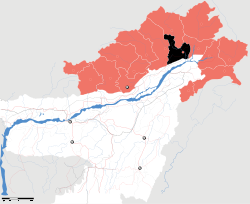East Siang district
| East Siang district | |
|---|---|
| District of Arunachal Pradesh | |
 Location of East Siang district in Arunachal Pradesh | |
| Country | India |
| State | Arunachal Pradesh |
| Headquarters | Pasighat |
| Government | |
| • Lok Sabha constituencies | Ninong Ering |
| • Assembly seats | Tatung Jamoh, Kaling Moyong, Tapang Taloh |
| Area | |
| • Total | 4,005 km2 (1,546 sq mi) |
| Population (2011) | |
| • Total | 99,019[1] (2,011) |
| • Urban | Yes |
| Demographics | |
| • Literacy | 73.5%[1] |
| • Sex ratio | 962[1] |
| Major highways | NH-52 |
| Website | Official website |
East Siang (Pron:/ˈsjæŋ or ˈsɪæŋ/) is an administrative district in the state of Arunachal Pradesh in India.
History
In 1989 territory was transferred from West Siang district to East Siang.[2] A decade later, in 1999, the district was bifurcated to make Upper Siang district.[2]
Geography
The district headquarters are located at Pasighat. East Siang district occupies an area of 4,005 square kilometres (1,546 sq mi),[3] comparatively equivalent to Indonesia's Nias Island.[4]
Divisions
There are 5 Arunachal Pradesh Legislative Assembly constituencies located in this district: Panging, Nari-Koyu, Pasighat West, Pasighat East, and Mebo. All of these are part of Arunachal East Lok Sabha constituency.[5]
Demographics
According to the 2011 census East Siang district has a population of 99,019,[1] roughly equal to the nation of Kiribati.[6] This gives it a ranking of 615th in India (out of a total of 640).[1] The district has a population density of 27 inhabitants per square kilometre (70/sq mi) .[1] Its population growth rate over the decade 2001–2011 was 13.3%.[1] East Siang has a sex ratio of 962 females for every 1000 males,[1] and a literacy rate of 73.54%.[1]
Various tribal groups of the Adi people live in various parts of the district. The local people traditionally follow Donyi-Polo, although a sizeable minority have converted to Christianity.
Languages
Languages spoken include Adi, a Sino-Tibetan tongue with approximately 140 000 speakers, written in both the Tibetan and Latin scripts;[7] and Galo, an endangered language with 30 000 speakers, also in the Sino-Tibetan language family.[8]
Flora and fauna
In 1978 East Siang district became home to the D’Ering Memorial (Lali) Wildlife Sanctuary, which has an area of 190 km2 (73.4 sq mi).[9]
References
- ↑ 1.0 1.1 1.2 1.3 1.4 1.5 1.6 1.7 1.8 "District Census 2011". Census2011.co.in.
- ↑ 2.0 2.1 Law, Gwillim (25 September 2011). "Districts of India". Statoids. Retrieved 2011-10-11.
- ↑ Srivastava, Dayawanti et al. (ed.) (2010). "States and Union Territories: Arunachal Pradesh: Government". India 2010: A Reference Annual (54th ed.). New Delhi, India: Additional Director General, Publications Division, Ministry of Information and Broadcasting (India), Government of India. p. 1113. ISBN 978-81-230-1617-7.
- ↑ "Island Directory Tables: Islands by Land Area". United Nations Environment Program. 18 February 1998. Retrieved 2011-10-11.
Nias 4,048km2
- ↑ "Assembly Constituencies allocation w.r.t District and Parliamentary Constituencies". Chief Electoral Officer, Arunachal Pradesh website. Retrieved 21 March 2011.
- ↑ US Directorate of Intelligence. "Country Comparison:Population". Retrieved 2011-10-01.
Kiribati 100,743 July 2011 est.
- ↑ M. Paul Lewis, ed. (2009). "Adi: A language of India". Ethnologue: Languages of the World (16th edition ed.). Dallas, Texas: SIL International. Retrieved 2011-09-28.
- ↑ M. Paul Lewis, ed. (2009). "Galo: A language of India". Ethnologue: Languages of the World (16th edition ed.). Dallas, Texas: SIL International. Retrieved 2011-09-28.
- ↑ Indian Ministry of Forests and Environment. "Protected areas: Arunachal Pradesh". Retrieved 25 September 2011.
External links
| Wikimedia Commons has media related to East Siang district. |
- Official website
- List of places in East-Siang
 |
Upper Siang district |  | ||
| West Siang district | |
Lower Dibang Valley district | ||
| ||||
| | ||||
| Dhemaji district, Assam |
| ||||||||||||||||||||||||||
| ||||||||||||||||||